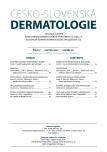-
Medical journals
- Career
Mongolian Spot
Authors: A. Havlínová
Authors‘ workplace: Dermatovenerologické oddělení Vojenské fakultní nemocnice Praha primář MUDr. Jaroslav Hoffmann
Published in: Čes-slov Derm, 92, 2017, No. 2, p. 77-82
Category:
Overview
Mongolian spot, or congenital dermal melanocytosis, is a benign birthmark, occuring mostly in babies of Mongolian race. It appears in the lumbo-sacro-coccygeal area and usually disappears spontaneously within the end of the toddler age. Although Mongolian Spots are benign in most cases, attention should be paid if they are unusually large, multiple, or appear in atypical areas of the body.
Key words:
Mongolian spot
Sources
1. ASHRAFI, MR., SHABANIAN, R., MOHAMMDI, M., KAVUSI, S. Extensive Mongolian spots: a clinical sign merits special attention. Pediatr. Neurol., 2006, 34, p. 143–145.
2. BOLOGNIA, JL., SCHAFFER, JV., DUNCAN, KO., KO, CJ. Dermatology Essentials. Hong Kong: Elsevier, 2014, p. 827, 895, 896.
3. BRAUN-FALCO, O., PLEWIG, G., LANDTHALER, M., BURGDORF, W., HERTL, M., RUZICKA, Th. Braun-Falco’s Dermatologie, Venerologie und Allergologie, 6. Auflage. Springer-Verlag Berlin Heidelberg, 2012, p. 1699.
4. BRYCHTA, P., STNEK, J. Et al. Estetická a plastická chirurgie a korektivní dermatologie. Praha: Grada Publishing a. s., 2014, p. 133–134.
5. CARHART, MC. Polynesia and polygenism: the scientific use of travel literature in the early 19th century. Hist. Human Sci., 2009, 22, p. 58–86.
6. CARPO, BG., GRAVELINIK, JM., GRAVLINIK, SV. Laser treatment of pigmented lesion in children. Semin. Cutan. Med. Surg., 1999, 18, p. 233–243.
7. CHAN, HH., KONO, T. Nevus Ota: clinical aspects ang management. Skinmed., 2003, 2, p. 86–89.
8. ČIHÁK, R. , DRUGA, R., GRIM, M., Anatomie 3, Druhé upravené a doplněné vydání. Praha: Grada Publishing a. s., 2004, p. 571, 573, 576.
9. ESTERLY, NB., WEISSBLUTH, CWA. Mongolian spots and GM1 type 1 gangliosidosis. J. Am. Acad Dermatol, 1990, 22, p. 320.
10. FEIT, J., JEDLIČKOVÁ, H., VLAŠÍN, Z., BURG, G., KEMPF, W., SCHÄRER, L., MATYSKA, L. Atlas dermatopatologie. Praha: Cesnet, 2015, 6.6.1.12.4. Zvláštní formy modrého névu.
11. GUPTA, D., THAPPA, DM. Mongolian spots: How important are they? World J. Of Clin. Cases, 2013, 1, p. 230–232.
12. GUPTA, D., THAPPA, DM. Mongolian spots. Indian J. Dermatol. Venerol. Leprol., 2013, 79, p. 469–478.
13. HANSON, M., LUPSKI, JR., HICKS, J., METRY., D. Association of dermal melanocytosis with lysosomal storage disease: clinical features and hypotheses regarding pathogenesis. Arch. Dermatol., 2003, 139, p. 916–920.
14. HURWITZ, S., PALLER, AS., MNCINI, AJ., Clinical Pediatric Dermatology, Fifth Edition. Toronto : Elsevier, 2016, p. 8, 9, 10, 203, 275, 276.
15. JEONG, S., LEMKE, BN., DORTZBACH, RK., PARK, YG., KANG, HK. The Asian upper eyelid: an anatomical study with comparison to the Caucasian eyelid. Arch. Ophthalmol. 1999, 117, p. 907–912.
16. JIRÁSKOVÁ, M. Pigmentové névy dětského věku. Pediatr. pro Praxi, 2006, 4, p. 190–193.
17. JORDAN, DR., ANDERSON, RL. Epicanthal folds. A deep tissue approach. Arch. Ophthalmol., 1989, 107, p. 1532–1535.
18. KAGAMI, S., ASHIA, A., WATANABE, R., MIMURA, Y., SHIRAI, A., HATTORI, N., WATANABE, T., TAMAKI, K. Laser treatment of 26 Japanese patients with Mongolian spots. Dermatol. Surg., 2008, 34, p. 1689–1694.
19. KAKIZAKI, H., ICHINOSE, A., NAKANO, T., ASAMOTO, K., IKEDA, H. Plast. Reconstr. Surg., 130, p. 49.
20. KANE, KS-M., RYDER, JB., JOHNSON, RA., BADEN, HP., STRATIGOS, A. Color Atlas & Synopsis of Pediatric Dermatology. New York, McGraw-Hill, 2002, p. 178–179.
21. LEUNG, AK., ROBSON, WL. Mongolian spots and GM1 gangliosiosis type one. J. Soc. Med.,1993, 86, p. 120–121.
22. LIPSON, M., LOH, PR., PATTERSON, N., MOORJANI, P., KO, YC., STONEKINNG, M., BERGER, B., REICH, D. Reconstructing Austronesian population history in Island Southeast Asia. Nat. Commun., 2014, 5, p. 4689.
23. MANISCALO, M., NOTO, G., ZICHICHI, L., RINALDI, R., MILAO, A., PATRIZI, A. Monolian spot. Incidence and natural history in western Sicily. Eur. J. Pediat. Dermatol., 2004, 14, p. 137–140.
24. McKEE, PH. Pathology of the Skin with Clinical Correlations, Second Edition. Barcelona : S. A. Arte sobre papel, 1996, p. 1324.
25. MUNTAU, AC., Pediatrie, 1. české vydání. Praha: Grada Publishing a. s., 2009, p. 450.
26. MURPHY, GF., HERZBERG, AJ. Atlas of Dermatopathology. Philadelphia: Saunders, 1995, p. 175.
27. PIZINGER, K. Doporučené postupy pro praktické lékaře. Melanocytové névy. Praha: ČLS JEP, 2002, p. 4.
28. OKUNOGHAE, E. Neurofibromatosis in a Toddler With Back Pain. J. Pediatr. Health Care, 2014, 28, p. 88–91.
29. RIVERS, JK., FREDERIKSEN, PC., DIBDIN, C. A prevalence survey of dermatoses in the Australian neonate. J. Am. Acad. Dermatol., 1990, 23, p. 77–81.
30. SELSOR, LC., LESHER, JLJ. Hyperpigmented macules and patches in a patient with GM 1 type gangliosdosis. J. Am. Acad. Dermatol., 1990, 20, p. 878.
31. ŠTORK, J. et al. Dermatovenerologie, Druhé vydání. Praha: Galén, 2013, p. 2, 5, 10, 348, 349, 350.
32. TANYASIRI, K., KONO, T., GROFF, WF., HIGASHIMORI, T., PETROVSKA, I., SAKURAI, H., NOZAKI, M. Mongolian spots with involvement of manibular area. J. Dermatol., 2007, 34, p. 381–384.
33. VLČEK, E. A contribution to the Antropology of the Khalkha-Mongols. Acta factualis rerum naturalium Univesitas Comenianae, Anthropologia, 1965, 9, p. 283–367.
34. WEISSBLUTH, M., ESTERLY, NB., CARO, WA. Report of an infant with GM1 type 1 gangliosidosis and extensit and anusual mongolian spots. Br. J. Dermatol., 1981, 104, p. 195.
35. WU, CY., CHEN, PH., CHEN, GS. Phacomatosis Cesioflammea Associated with Pectus Excavatum. Acta Dermato-Venerologica, 2009, 89, p. 309–310.
Labels
Dermatology & STDs Paediatric dermatology & STDs
Article was published inCzech-Slovak Dermatology

2017 Issue 2
Most read in this issue
Login#ADS_BOTTOM_SCRIPTS#Forgotten passwordEnter the email address that you registered with. We will send you instructions on how to set a new password.
- Career
